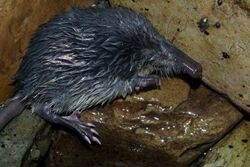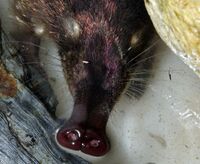Biology:Pyrenean desman
| Pyrenean desman[1] | |
|---|---|

| |
| Scientific classification | |
| Domain: | Eukaryota |
| Kingdom: | Animalia |
| Phylum: | Chordata |
| Class: | Mammalia |
| Order: | Eulipotyphla |
| Family: | Talpidae |
| Genus: | Galemys |
| Species: | G. pyrenaicus
|
| Binomial name | |
| Galemys pyrenaicus (É. Geoffroy, 1811)
| |

| |
Galemys pyrenaicus pyrenaicus
Galemys pyrenaicus rufulus
| |
The Pyrenean desman or Iberian desman (Galemys pyrenaicus) is a small semiaquatic, globally threatened mammal related to moles and shrews, and, along with the Russian desman (Desmana moschata), is one of the two extant members of the tribe Desmanini.[2][3] The species occurs in north and central parts of Spain and Portugal, French Pyrenees, and Andorra,[2] but severe range contractions have been documented across its geographic distribution.[4]
Description

The Pyrenean desman is 11 to 14 cm (4.3 to 5.5 in) long with a rounded scale-covered tail of 12 to 16 cm (4.7 to 6.3 in), and weighs 35 to 80 g (1.2 to 2.8 oz).[3] They have a long, sensitive nasal trompe provided with hypertrophic vibrissae and chemo-/mechanosensitive Eimer's organs helping prey detection, and large webbed feet with fringed hairs to increase the swimming surface, and can close off their nostrils and ears to stop water penetration.[3][5]
The desman's body is covered in dark, brownish fur, with the exception of its tail and nose. The nose is black and is covered in vibrissae (facial hairs), which it uses to feel the movement of prey as it sticks its nose into mud or crevices while searching for food. The Pyrenean desman can live at least 3.5 years. The animals are mostly nocturnal, and eat small invertebrates, mostly aquatic macroinvertebrates. They breed up to three times a year, with the period of gestation lasting around thirty days.
Three to four young are born in each litter. The males have a slightly larger territory than the female. Both males and females scent mark. They are thought to be aggressive towards other adult members of the species.[3][6]
Habitat
Pyrenean desmans are proficient swimmers, suited to their aquatic habitat, although their claws also allow them to be good at climbing. They mostly occur in fast-flowing, mountainous rivers with shallow waters and good riparian galleries. The habitat of the Pyrenean desman is under threat, and recent studies have shown dramatic declines in species occurrence in several parts of its range in the last few decades [4][7]
Conservation
Threats include habitat fragmentation and alteration, invasive species (e.g. the American mink), and climate change.[4][7]
The Photo Ark
On May 4, 2018, National Geographic reported that the Pyrenean desman was the 8,000th animal photographed for The Photo Ark by Joel Sartore.[8]
References
- ↑ Hutterer, R. (2005). "Order Soricomorpha". in Wilson, D.E.; Reeder, D.M. Mammal Species of the World: A Taxonomic and Geographic Reference (3rd ed.). Johns Hopkins University Press. p. 303. ISBN 978-0-8018-8221-0. OCLC 62265494. http://www.departments.bucknell.edu/biology/resources/msw3/browse.asp?id=13700680.
- ↑ 2.0 2.1 2.2 Quaglietta, L. (2022). "Galemys pyrenaicus". IUCN Red List of Threatened Species 2022: e.T8826A214429993. doi:10.2305/IUCN.UK.2022-1.RLTS.T8826A214429993.en. https://www.iucnredlist.org/species/8826/214429993.
- ↑ 3.0 3.1 3.2 3.3 Palmeirim, J. M.; Hoffmann, R. S. (1983). "Galemys pyrenaicus". Mammalian Species (207): 1–5. doi:10.2307/3503939.
- ↑ 4.0 4.1 4.2 Quaglietta, L.; Paupério, J.; Martins, F.; Alves, P.C.; Beja, P. (20 June 2018). "Recent range contractions in the globally threatened Pyrenean desman highlight the importance of stream headwater refugia". Animal Conservation 21 (6): 515–525. doi:10.1111/acv.12422.
- ↑ Quaglietta, L. (2018). "Semi-aquatic". Encyclopedia of Animal Cognition and Behavior. Springer, Cham. pp. 1–6. doi:10.1007/978-3-319-47829-6_394-1. ISBN 978-3-319-47829-6.
- ↑ Stone, R. D. (1987). "The social ecology of the Pyrenean desman (Galemys pyrenaicus)(Insectivora: Talpidae), as revealed by radiotelemetry". Journal of Zoology 212 (1): 117–129. doi:10.1111/j.1469-7998.1987.tb05119.x.
- ↑ 7.0 7.1 Charbonnel, A.; Laffaille, P.; Biffi, M.; Blanc, F.; Maire, A.; Némoz, M.; Sanchez-Perez, JM.; Sauvage, S et al. (2016). "Can recent global changes explain the dramatic range contraction of an endangered semi-aquatic mammal species in the French Pyrenees?". PLOS ONE 11 (7): e0159941. doi:10.1371/journal.pone.0159941. PMID 27467269. Bibcode: 2016PLoSO..1159941C.
- ↑ Gibbens, Sarah (May 4, 2018). "Aquatic Mammal With Snorkel Nose Is 8,000th Animal in Our Photo Ark". National Geographic. https://news.nationalgeographic.com/2018/05/pyrenean-desman-photo-ark-joel-sartore-animals-spd/.
Wikidata ☰ Q754036 entry
 |


